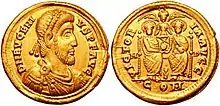Theodosius I
Theodosius I (Greek: Θεοδόσιος; 11 January 347 – 17 January 395), also called Theodosius the Great, was Roman emperor from 379 to 395. He is best known for making Christianity the state religion of the Roman Empire and great architecture projects in Constantinople.
| Theodosius I | |||||||||||||
|---|---|---|---|---|---|---|---|---|---|---|---|---|---|
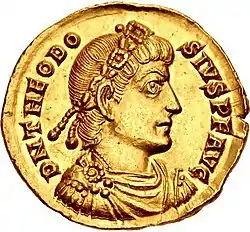 Solidus depicting Theodosius, marked: d n theodosius p f aug ("Our Lord Theodosius, pious, fortunate, august") | |||||||||||||
| Roman emperor | |||||||||||||
| Augustus | 19 January 379 – 17 January 395 | ||||||||||||
| Predecessor | Valens | ||||||||||||
| Successor | Arcadius (East) Honorius (West) | ||||||||||||
| Alongside | Gratian (379–383) Valentinian II (379–392) Magnus Maximus (384–388) Victor (384–388) Eugenius (392–394) Arcadius (383–395) Honorius (393–395) | ||||||||||||
| Born | 11 January 347 Cauca (Coca, Spain) | ||||||||||||
| Died | 17 January 395 (aged 48) Mediolanum (Milan, Italy) | ||||||||||||
| Burial | |||||||||||||
| Spouse |
| ||||||||||||
| Issue more... | |||||||||||||
| |||||||||||||
| Dynasty | Theodosian | ||||||||||||
| Father | Count Theodosius | ||||||||||||
| Mother | Thermantia | ||||||||||||
| Religion | Nicene Christianity | ||||||||||||
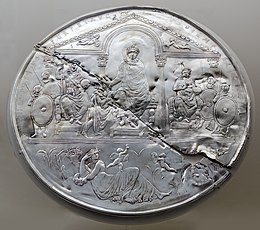
After a military career and a governorship under his father Theodosius the Elder – a comes rei militaris – he became magister equitum and was then elevated to the imperial rank of augustus by the emperor Gratian (r. 367–383). He replaced the latter's uncle and senior augustus Valens (r. 364–378), who had been killed in the Battle of Adrianople. He was the first emperor of the Theodosian dynasty (r. 379–457), and married into the ruling Valentinianic dynasty (r. 364–455). On accepting his elevation, he campaigned with limited success against Goths and other barbarians who had invaded the Empire. He was not able to destroy them or drive them out, as had been Roman policy for centuries in dealing with invaders. The Gothic War ended with the Goths established as autonomous allies of the Empire, within the Empire's borders, south of the Danube. They were given lands and allowed to remain under their own leaders, not assimilated as had been normal Roman practice.
He issued decrees that effectively made Nicene Christianity the official state religion of the Roman Empire, including the Edict of Thessalonica.[3][4] He dissolved the order of the Vestal Virgins in Rome's Temple of Vesta. In 393, he banned the pagan rituals of the Olympic Games. His decrees made Nicene Christianity the state church of the Roman Empire and punished Roman paganism, Hellenistic religion, and Arianism. He neither prevented nor punished the destruction of prominent Hellenistic temples of classical antiquity, including the Temple of Apollo in Delphi and the Serapeum in Alexandria. At his capital Constantinople he commissioned the honorific Column of Theodosius, the Theodosian Walls, and the Golden Gate, among the greatest surviving works of ancient Roman architecture. His management of the empire was marked by heavy tax exactions, and by a court in which "everything was for sale".[5]
Theodosius married Gratian's half-sister Galla, daughter of Valentinian the Great (r. 364–375), and defeated the rebellion of Magnus Maximus (r. 383–388) on behalf of his new brother-in-law, Valentinian II (r. 375–392). This victory came at heavy cost to the strength of the Empire. When Valentinian II died, Theodosius became the senior emperor, having already made his eldest son Arcadius his co-augustus. Theodosius then defeated the usurper Eugenius (r. 392–394), in another destructive civil war. He died a few months later, without having consolidated control of his armies or of his Gothic allies. After his death, Theodosius's young and incapable sons were the two augusti. Arcadius (r. 383–408) inherited the eastern empire and reigned from Constantinople, and Honorius (r. 393–423) the western empire. The two courts spent much of their effort in attacking each other or in vicious internal power struggles. The administrative division endured until the fall of the western Roman empire in the late 5th century.
Theodosius is considered a saint by the Catholic, Eastern Orthodox, and Oriental Orthodox churches, and his feast day is on January 17.[6]
Early life
According to Polemius Silvius, Theodosius the Great was born on 11 January 347 or 346.[7] The epitome de Caesaribus places his birthplace at Cauca (Coca, Segovia) in Hispania.[7] According to the traditional texts of the chronicle of Hydatius and Zosimus, he was born at "Cauca in Gallaecia".[8][9][10] These texts are probably corrupted with interpolations, as Cauca was in fact not part of the province of Gallaecia, while according to Themistius, Claudian, and Marcellinus Comes, he was born at Italica in Hispania Baetica.[10] These claims were probably fictitious and intended to connect Theodosius with the lineage of his distant predecessor Trajan (r. 98–117), who had came from Italica.[7]
Thedosius's father was Theodosius the Elder and his mother was Thermantia.[7]
Theodosius had a brother named Honorius, a sister referred to in Aurelius Victor's De caesaribus but whose name is unknown, and a niece, Serena.[7]
Military career
Theodosius accompanied his father, the comes rei militaris, on his 368–369 campaign against the Franks, Scots, and Saxons to restore order and the rule of the emperors Valentinian I (r. 364–375) and Valens (r. 364–378) in Roman Britain, which had been threatened in 367 by the Great Conspiracy.[11][12][7] They also defeated the usurpation in Britain by Valentinus.[12] Previous to this in 366, Theodosius the Elder attacked and defeated the Alamanni in Roman Gaul; the defeated prisoners had been resettled in the Po Valley.[13][14]
Theodosius the Elder was made magister equitum in 369, and retained the post until 375.[7] Theodosius and his father campaigned against the Alamanni 370.[7] The two Theodosi campaigned against Sarmatians in 372/373.[7] The emperors' rule in Roman Africa was disrupted by the revolt of Firmus in 373.[15] Theodosius the Elder moved to defeat the usurpation.[15]
In about 373, Theodosius was made dux of the province of Moesia Prima.[16] In 374, the Quadi and their allies the Sarmatians overran the province of Valeria in the praetorian prefecture of Illyricum.[17] Theodosius drove the Sarmatians out of the Roman territory and then defeated the Quadi.[18][19] He is reported to have defended his province with marked ability and success.[18]
Theodosius the Elder fell from power in 375, and Theodosius the dux of Moesia Prima retired to his estates in the Iberian Peninsula, where he married Aelia Flaccilla in 376.[7] Their first child, Arcadius, was born around 377.[7] Pulcheria, their daughter, was born in 377 or 378.[7] Theodosius had returned to the Danube frontier by 378, when he was appointed magister equitum.[7]
Accession
After the death of his uncle Valens (r. 364–378), Gratian, now the senior augustus, sought a candidate to nominate as Valens's successor. On 19 January 379, Theodosius I was made augustus over the eastern provinces at Sirmium.[7][20] His wife, Aelia Flaccilla, was accordingly raised to augusta.[7] The new augustus's territory spanned the Roman praetorian prefecture of the East, including the Roman diocese of Thrace, and the additional dioceses of Dacia and of Macedonia. Theodosius the Elder, who had died in 375, was then deified as: Divus Theodosius Pater, lit. 'the Divine Father Theodosius'.[7]
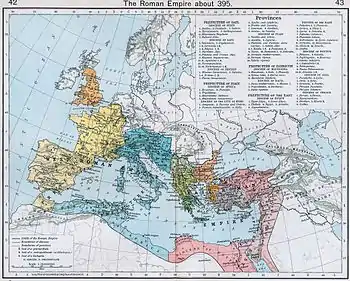
Reign
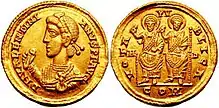
Early reign: 379–383
In October 379 the Council of Antioch was convened.[7] On 27 February 380 Theodosius issued the Edict of Thessalonica, making Nicene Christianity the state church of the Roman Empire.[7] In 380, Theodosius was made Roman consul for the first time and Gratian for the fifth; in September the augusti Gratian and Theodosius met, returning the Roman diocese of Dacia to Gratian's control and that of Macedonia to Valentinian II.[20][7] In autumn Theodosius fell ill, and was baptized.[7] According to the Consularia Constantinopolitana, Theodosius arrived at Constantinople and staged an adventus, a ritual entry to the capital, on 24 November 380.[7]
Theodosius issued a decree against Christians deemed heretics on 10 January 381.[7] According to the Consularia Constantinopolitana, on the 11 January, Athanaric, king of the Gothic Thervingi arrived in Constantinople; he died and was buried in Constantinople on 25 January.[7] On 8 May 381, Theodosius issued an edict against Manichaeism.[7] In mid-May, Theodosius convened the First Council of Constantinople, the second ecumenical council after Constantine's First Council of Nicaea in 325; the Constantinopolitan council ended on 9 July.[7] According to Zosimus, Theodosius won a victory over the Carpi and the Scirii in summer 381.[7] On 21 December, Theodosius decreed the prohibition of sacrifices with the intent of divining the future.[7] On 21 February 382, the body of Theodosius's father in law Valentinian the Great was finally laid to rest in the Church of the Holy Apostles.[7] Another Council of Constantinople was held in summer 382.[7] According to the Consularia Constantinopolitana, a treaty of foedus was reached with the Goths, and they were settled between the Danube and the Balkan Mountains.[7]
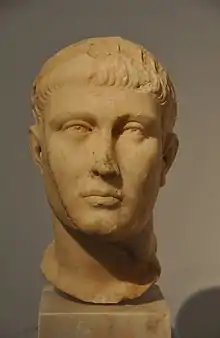
Temporary settlement of the Gothic Wars
The Goths and their allies (Vandals, Taifals, Bastarnae and the native Carpians) entrenched in the provinces of Dacia and eastern Pannonia Inferior consumed Theodosius's attention. The Gothic crisis was so dire that his co-Emperor Gratian relinquished control of the Illyrian provinces and retired to Trier in Gaul to let Theodosius operate without hindrance. It did not help that Theodosius himself was dangerously ill during many months after his elevation, being confined to his bed in Thessalonica during much of 379.[22]
Gratian suppressed the incursions into dioceses of Illyria (Pannonia and Dalmatia) by Alathaeus and Saphrax in 380.[23] He succeeded in convincing both to agree to a treaty and be settled in Pannonia.[24] Theodosius was able finally to enter Constantinople in November 380, after two seasons in the field, having ultimately prevailed by offering highly favorable terms to the Gothic chiefs.[23] His task was rendered much easier when Athanaric, an aged and cautious leader, accepted Theodosius's invitation to a conference in the capital, Constantinople, and the splendor of the imperial city reportedly awed him and his fellow-chiefs into accepting Theodosius' offers.[25] Athanaric himself died soon after, but his followers were impressed by the honorable funeral arranged for him by Theodosius, and agreed to defending the border of the empire.[25] The final treaties with the remaining Gothic forces, signed 3 October 382, permitted large contingents of barbarians, primarily Thervingian Goths, to settle in Thrace south of the Danube frontier.[26] The Goths now settled within the Empire would largely fight for the Romans as a national contingent, as opposed to being fully integrated into the Roman forces.[26]
.png.webp)
First civil war: 383–384
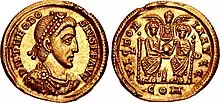
According to the Chronicon Paschale, Theodosius celebrated his quinquennalia on 19 January 383 at Constantinople; on this occasion he raised his eldest son Arcadius to co-augustus.[7] Early 383 saw the acclamation of Magnus Maximus as augustus in Britain and the appointment of Themistius as praefectus urbi in Constantinople.[7] On 25 July, Theodosius issued a new edict against gatherings of Christians deemed heretics.[7]
Theodosius, unable to do much about Maximus due to his still inadequate military capability, opened negotiations with the Persian emperor Shapur III (r. 383–388) of the Sasanian Empire.[27] In an attempt to curb Maximus's ambitions, Theodosius appointed Flavius Neoterius as praetorian prefect of Italy.[28]
Sometime in 383, Gratian's wife Constantia died.[20] Gratian remarried, wedding Laeta, whose father was a consularis of Roman Syria.[29] On the 25 August 383, according to the Consularia Constantinopolitana, Gratian was killed at Lugdunum (Lyon) by Andragathius, the magister equitum of the rebel augustus during the rebellion of Magnus Maximus .[20] Constantia's body arrived in Constantinople on 12 September that year and was buried in the Church of the Holy Apostles on 1 December.[20] Gratian was deified as Latin: Divus Gratianus, lit. 'the Divine Gratian'.[20]
On 21 January 384 all those deemed heretics were expelled from Constantinople.[7] According to the Consularia Constantinopolitana, Theodosius received in Constantinople an embassy from the Sasanian Empire in 384.[7] In summer 384, Theodosius met his co-augustus Valentinian II in northern Italy.[30][7] Theodosius brokered a peace agreement between Valentinian and Magnus Maximus which endured for several years.[31]
Middle reign: 384–387
Theodosius's second son Honorius was born on 9 December 384 and titled nobilissimus puer (or nobilissimus iuvenis).[7] The death of Aelia Flaccilla, Theodosius's first wife and the mother of Arcadius, Honorius, and Pulcheria, occurred by 386.[7] She died at Scotumis in Thrace and was buried at Constantinople, her funeral oration delivered by Gregory of Nyssa.[7][32] A statue of her was dedicated in the Byzantine Senate.[32] In 384 or 385, Theodosius's niece Serena was married to the magister militum, Stilicho.[7] On 25 May 385, Theodosius repeated the ban on sacrifices that were done in order to predict the future.[7]
In the beginning of 386, Theodosius's daughter Pulcheria also died.[7] That summer more Goths were defeated, and many were settled in Phrygia.[7] According to the Consularia Constantinopolitana, a Roman triumph over the Gothic Greuthungi was then celebrated at Constantinople.[7] The same year, work began on the great triumphal column in the Forum of Theodosius in Constantinople, the Column of Theodosius.[7] On 19 January 387, according to the Consularia Constantinopolitana, Arcadius celebrated his quinquennalia in Constantinople.[7] By the end of the month, there was an uprising or riot in Antioch (Antakya).[7] With a peace agreement with Persia in the Roman–Persian Wars came a division of Armenia.[7]
Second civil war: 387–388
The peace with Magnus Maximus was broken in 387, and Valentinian escaped the west with Justina, reaching Thessalonica (Thessaloniki) in summer or autumn 387 and appealing to Theodosius for aid; Valentinian II's sister Galla was then married to the eastern augustus at Thessalonica in late autumn.[30][7] Theodosius may still have been in Thessalonica when he celebrated his decennalia on 19 January 388.[7] Theodosius was consul for the second time in 388.[7] Galla and Theodosius's first child, a son named Gratian, was born in 388 or 389.[7]
On 10 March 388, Christians deemed heretics were forbidden from residing in cities.[7] On 14 March, Theodosius banned the intermarriage of Jews and Christians.[7] In summer 388, Theodosius recovered Italy from Magnus Maximus for Valentinian, and in June, the meeting of Christians deemed heretics was banned by Valentinian.[30][7]
The armies of Theodosius and Maximus fought at the Battle of Poetovio in 388, which saw Maximus defeated. On 28 August 388 Maximus was executed.[33] Now the de facto ruler of the Western empire as well, Theodosius celebrated his victory in Rome on June 13, 389 and stayed in Milan until 391, installing his own loyalists in senior positions including the new magister militum of the West, the Frankish general Arbogast.[33]
Around July, Magnus Maximus was defeated by Theodosius at the Battle of Save; on 28 August, Magnus Maximus was executed by Theodosius.[7] According to the Consularia Constantinopolitana, Arbogast killed Flavius Victor (r. 384–388), Magnus Maximus's young son and co-augustus, in Gaul in August/September that year. Damnatio memoriae was pronounced against them, and inscriptions naming them were erased.[7]
Massacre and exclusion from church: 388–391
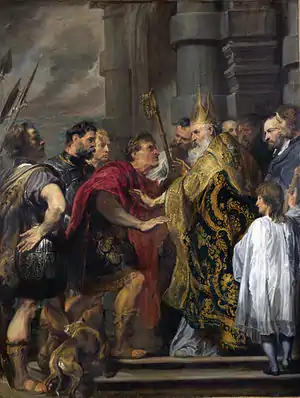
Theodosius came into conflict with Ambrose, bishop of Mediolanum (Milan), in October 388 over the persecution of Jews at Callinicum-on-the-Euphrates (Raqqa).[7] As mentioned in the Panegyrici Latini and in a panegyric of Claudian's on the sixth consulship of Honorius, Theodosius then received another embassy from the Persians in 389.[7] According to the Consularia Constantinopolitana, Theodosius staged an adventus, a formal spectacle, on entering Rome on 13 June 389.[7] On 17 June, he issued a decree against Manichaeism.[7] Theodosius had left Valentinian under the protection of the magister militum Arbogast, who then defeated the Franks in 389.[31][30]
In 390 the population of Thessalonica rioted in complaint against the presence of the local Gothic garrison. The garrison commander was killed in the violence, so Theodosius ordered the Goths to kill all the spectators in the circus as retaliation, an event known as the Massacre of Thessalonica; Theodoret, a contemporary witness to these events, reports:
... the anger of the Emperor rose to the highest pitch, and he gratified his vindictive desire for vengeance by unsheathing the sword most unjustly and tyrannically against all, slaying the innocent and guilty alike. It is said seven thousand perished without any forms of law, and without even having judicial sentence passed upon them; but that, like ears of wheat in the time of harvest, they were alike cut down.[34]
Ambrose refused to admit Theodosius to church.[35] Ambrose told Theodosius to imitate David in his repentance as he had imitated him in guilt, demanding that the emperor do penance for the massacre.[7] According to the 5th-century church historian Theodoret, on 25 December 390 (Christmas), Ambrose received Theodosius back into the Christian Church in his bishopric of Mediolanum.[7]
According to the Chronicon Paschale, on 18 February 391, the head of John the Baptist was translated to Constantinople.[7] On the 24 February, attendance at pagan sacrifices and temples was forbidden by law.[7] In early summer 391, an uprising in Alexandria was suppressed, and Christian mobs destroyed the Serapeum of Alexandria.[7] On 16 June, pagan worship was prohibited by law.[7] In 391, Theodosius, by then in Gaul, snubbed a delegation from the Roman Senate in Gaul because of the reappearance of the Altar of Victory in the Curia Julia.[30]
According to Zosimus, Theodosius then campaigned against marauding barbarian bandits in Macedonia in autumn 391.[7] Eventually, he came to Constantinople, where according to Socrates Scholasticus's Historia Ecclesiastica he held an adventus, entering the city on 10 November 391.[7]
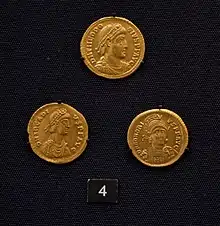
Third civil war: 392–394
On 15 May 392, Valentinian II died at Vienna in Gaul (Vienne), either by suicide or as part of a plot by the magister militum Arbogast.[30] Valentinian had quarrelled publicly with Arbogast, and was found hanged in his room.[36] Arbogast announced that this had been a suicide.[36] He was deified with the consecratio: Divae Memoriae Valentinianus, lit. 'the Divine Memory of Valentinian'.[30]
Theodosius was then sole adult emperor, reigning with his son Arcadius. Arbogast was unable to assume the role of emperor because of his non-Roman background.[36] Instead, on 22 August at the behest of Arbogast, a magister scrinii and vir clarissimus, Eugenius, was acclaimed augustus at Lugdunum.[7] Eugenius made some limited concessions to the Roman religion; like Maximus he sought Theodosius's recognition in vain.[36] On 8 November 392, all cult worship of the gods was forbidden by Theodosius.[7]
According to Polemius Silvius, Theodosius raised his second son Honorius to augustus on 23 January 393.[7] He cited Eugenius's illegitimacy.[36] 393 was the year of Theodosius's third consulship.[7] On 29 September 393, Theodosius issued a decree for the protection of Jews.[7] According to Zosimus, at the end of April 394, Theodosius's wife Galla died.[7] On 1 August, a colossal statue of Theodosius was dedicated in Constantinople's Forum of Theodosius, an event recorded in the Chronicon Paschale.[7]
In the last years of Theodosius's reign, one of the emerging leaders of the Goths, named Alaric, participated in Theodosius's campaign against Eugenius in 394, only to resume his rebellious behavior against Theodosius's son and eastern successor, Arcadius, shortly after Theodosius' death.
Theodosius had gathered a large army, including the Goths whom he had settled in the eastern empire as foederati, as well as Caucasian and Saracen auxiliaries, and marched against Eugenius.[37] According to Socrates Scholasticus, Theodosius defeated Eugenius at the Battle of the Frigidus (the Vipava) on 6 September 394.[7]
The battle began on 5 September 394, with Theodosius' full frontal assault on Eugenius's forces. Theodosius was repulsed on the first day, and Eugenius thought the battle to be all but over. In Theodosius's camp, the loss of the day decreased morale. It is said that Theodosius was visited by two "heavenly riders all in white" who gave him courage. The next day, the battle began again and Theodosius's forces were aided by a natural phenomenon known as the Bora, which can produce hurricane-strength winds.[38] The Bora blew directly against the forces of Eugenius and disrupted the line. Eugenius's camp was stormed; Eugenius was captured and soon after executed.[38] On 8 September, Arbogast killed himself.[7]
According to Socrates, on 1 January 395, Honorius arrived in Mediolanum and a victory celebration was held there.[7]
Death
Theodosius suffered from a disease involving severe edema, in Milan.[39] According to the Consularia Constantinopolitana, Theodosius died in Mediolanum on 17 January 395.[7] His funeral was held there on 25 February.[7] Ambrose delivered a panegyric titled De obitu Theodosii in the presence Stilicho and Honorius in which Ambrose praised the suppression of paganism by Theodosius.[39]
His body transferred to Constantinople, where according to the Chronicon Paschale he was buried on 8 November 395 in the Church of the Holy Apostles.[7] He was deified as: Divus Theodosius, lit. 'the Divine Theodosius'.[7] He was interred in a porphyry sarcophagus that was described in the 10th century by Constantine VII Porphyrogenitus in his work De Ceremoniis.[40]
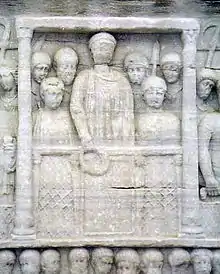
Art patronage
Theodosius oversaw the removal in 390 of an Egyptian obelisk from Alexandria to Constantinople.[41] It is now known as the obelisk of Theodosius and still stands in the Hippodrome of Constantinople,[41] the long Roman circus that was the centre of Constantinople's public life and scene of political turmoil. Re-erecting the monolith was a challenge for the technology that had been honed in the construction of siege engines. The obelisk, still recognizably a solar symbol, had been moved from Karnak to Alexandria with what is now the Lateran obelisk by Constantius II.
The Lateran obelisk was shipped to Rome soon afterwards, but the other one then spent a generation lying at the docks due to the difficulty involved in attempting to ship it to Constantinople. Eventually, the obelisk was cracked in transit. The white marble base is entirely covered with bas-reliefs documenting the imperial household and the engineering feat of removing it to Constantinople. Theodosius and the imperial family are separated from the nobles among the spectators in the imperial box, with a cover over them as a mark of their status. The naturalism of traditional Roman art in such scenes gave way in these reliefs to conceptual art: the idea of order, decorum and respective ranking, expressed in serried ranks of faces. This is seen as evidence of formal themes beginning to oust the transitory details of mundane life, celebrated in Roman portraiture.
The Forum Tauri in Constantinople was renamed and redecorated as the Forum of Theodosius, including a column and a triumphal arch in his honour.[42]

Religious policy
Arianism
In 325, Constantine I convened the Council of Nicaea, which affirmed the doctrine that Jesus, the Son, was equal to God the Father and "of one substance" with the Father (homoousios in Greek). The Council condemned the teachings of Arius, who believed Jesus to be inferior to the Father.
Despite the council's ruling, controversy continued for decades, with several christological alternatives to the Nicene Creed being brought forth. Theologians attempted to bypass the Christological debate by saying that Jesus was merely like (homoios in Greek) God the father, without speaking of substance (ousia). These non-Nicenes were frequently labelled as Arians (i.e., followers of Arius) by their opponents, though not all would necessarily have identified themselves as such.[43]
The Emperor Valens had favored the group who used the homoios formula; this theology was prominent in much of the East and had under Constantius II gained a foothold in the West, being ratified by the Council of Ariminum, though it was later abjured by a majority of the western bishops (after Constantius II's death in 361). The death of Valens damaged the standing of the Homoian faction, especially since his successor Theodosius steadfastly held to the Nicene Creed which was the interpretation that predominated in the West and was held by the important Alexandrian church.
Definition of orthodoxy
_-_Ambrogio_impone_penitenza_a_Teodosio_-_Foto_Giovanni_Dall'Orto_-_9-July-2007.jpg.webp)
On 27 February 380, together with Gratian and Valentinian II, Theodosius issued the decree "Cunctos populos", the so-called Edict of Thessalonica, recorded in the Codex Theodosianus xvi.1.2. This declared the Nicene Trinitarian Christianity to be the only legitimate imperial religion and the only one entitled to call itself Catholic; non-Christian religions or those who did not support the Trinity, he described as "foolish madmen".[44] He also ended official state support for the traditional polytheist religions and customs.[45]
On 26 November 380, two days after he had arrived in Constantinople, Theodosius expelled the Homoian bishop, Demophilus of Constantinople, and appointed Meletius patriarch of Antioch, and Gregory of Nazianzus, one of the Cappadocian Fathers from Cappadocia (today in Turkey), patriarch of Constantinople. Theodosius had just been baptized, by bishop Ascholius of Thessalonica, during a severe illness.
In May 381, Theodosius summoned a new ecumenical council at Constantinople to repair the schism between East and West on the basis of Nicene orthodoxy.[46] The council went on to define orthodoxy, including the Third Person of the Trinity, the Holy Spirit, as equal to the Father and 'proceeding' from Him, whereas the Son was 'begotten' of Him.[47] The council also "condemned the Apollonarian and Macedonian heresies, clarified jurisdictions of the bishops according to the civil boundaries of dioceses and ruled that Constantinople was second in precedence to Rome."[47]
Proscription of pagan religion
The persecution of pagans under Theodosius I began in 381, after the first couple of years of his reign in the Eastern Roman Empire. In the 380s, Theodosius I reiterated Constantine's ban on some practices of Roman religion, prohibited haruspicy on pain of death, decreed magistrates who did not enforce laws against polytheism were subject to criminal prosecution, broke up some pagan associations and tolerated attacks on Roman temples.
In 391 and 392 Theodosius promulgated three laws restricting pagan religious practices. The first, issued in June 391 and addressed to the urban prefect of Rome, banned ritual sacrifice and access to temples, with heavy fines for infractors. A similar measure was addressed to Alexandria in June 392. These two laws were apparently aimed at public officials specifically and not binding on the population at large.[48] The third and more extreme law, issued in November 392, prohibited pagan worship in every form, including animal sacrifice and offerings of incense and wine, again threatening offenders with confiscation of property.[49] This measure was addressed specifically to the praetorian prefect of the East, the staunchly Christian Rufinus, and there is seemingly no evidence of its application in the West, where Theodosius himself appointed several pagans to high office to mollify them.[50] He turned pagan holidays into workdays, closed temples, confiscated Temple endowments and disbanded the Vestal Virgins.[51] The practices of taking auspices and witchcraft were punished. Theodosius refused to restore the Altar of Victory in the Senate House, as asked by non-Christian senators.[52]:115
From 392 until his death in 395, while non-Christians continued to request toleration,[53][54] he ordered, authorized, or at least failed to punish, the closure or destruction of many temples, holy sites, images and objects of piety throughout the empire.[55][56][57][58][59]
In 393 he issued a comprehensive law that prohibited any public non-Christian religious customs,[60] and was particularly oppressive to Manicheans.[61] He is likely to have discontinued the ancient Olympic Games, whose last record of celebration was in 393, though archeological evidence indicates that some games were still held after this date.[62]
See also
- Battle of Frigidus
- De Fide Catolica
- Galla Placidia, daughter of Theodosius
- List of Byzantine emperors
- Roman emperors family tree
- Saint Fana
- Serena, niece of Theodosius and wife of Flavius Stilicho
- Zosimus, pagan historian from the time of Anastasius I
References
- Cooley, Alison E. (2012). The Cambridge Manual of Latin Epigraphy. Cambridge University Press. p. 506. ISBN 978-0-521-84026-2.
- Kienast, Dietmar (2017) [1990]. "Theodosius". Römische Kaisertabelle: Grundzüge einer römischen Kaiserchronologie (in German). WBG. pp. 323–329. ISBN 978-3-534-26724-8.
- Cf. decree, infra.
- "Edict of Thessalonica": See Codex Theodosianus XVI.1.2
- Brown, Peter (2012). Through the Eye of a Needle. Princeton University Press. pp. 145–146. ISBN 978-0-691-16177-8. Quoting Paulinus of Milan's Life of Ambrose.
- http://www.saint.gr/1118/saint.aspx
- Kienast, Dietmar (2017) [1990]. "Theodosius I". Römische Kaisertabelle: Grundzüge einer römischen Kaiserchronologie (in German). Darmstadt: Wissenschaftliche Buchgesellschaft. pp. 323–326. ISBN 978-3-534-26724-8.
- Zos. Historia Nova 4.24.4.
- Hydatius Chronicon, year 379, II.
- Alicia M. Canto, "Sobre el origen bético de Teodosio I el Grande, y su improbable nacimiento en Cauca de Gallaecia", Latomus 65/2, 2006, 388-421. The author points out that the city of Cauca was not part of Gallaecia, and demonstrates the probable interpolations of the traditional texts of Hydatius and Zosimus.
- Bond, Sarah; Darley, Rebecca (2018), Nicholson, Oliver (ed.), "Valentinian I", The Oxford Dictionary of Late Antiquity, Oxford University Press, doi:10.1093/acref/9780198662778.001.0001, ISBN 978-0-19-866277-8, retrieved 24 October 2020
- Kienast, Dietmar (2017) [1990]. "Valentinianus". Römische Kaisertabelle: Grundzüge einer römischen Kaiserchronologie (in German). Darmstadt: Wissenschaftliche Buchgesellschaft. pp. 313–315. ISBN 978-3-534-26724-8.
- Bond, Sarah; Darley, Rebecca (2018), Nicholson, Oliver (ed.), "Valentinian I", The Oxford Dictionary of Late Antiquity, Oxford University Press, doi:10.1093/acref/9780198662778.001.0001, ISBN 978-0-19-866277-8, retrieved 24 October 2020
- Kienast, Dietmar (2017) [1990]. "Valentinianus". Römische Kaisertabelle: Grundzüge einer römischen Kaiserchronologie (in German). Darmstadt: Wissenschaftliche Buchgesellschaft. pp. 313–315. ISBN 978-3-534-26724-8.
- Bond, Sarah; Darley, Rebecca (2018), Nicholson, Oliver (ed.), "Valentinian I", The Oxford Dictionary of Late Antiquity, Oxford University Press, doi:10.1093/acref/9780198662778.001.0001, ISBN 978-0-19-866277-8, retrieved 24 October 2020
- Kienast, Dietmar (2017) [1990]. "Theodosius I". Römische Kaisertabelle: Grundzüge einer römischen Kaiserchronologie (in German). Darmstadt: Wissenschaftliche Buchgesellschaft. pp. 323–326. ISBN 978-3-534-26724-8.
- Hughes 2013, p. 127.
- Williams & Friell 1995, p. 13.
- Hughes 2013, p. 128.
- Kienast, Dietmar (2017) [1990]. "Gratianus". Römische Kaisertabelle: Grundzüge einer römischen Kaiserchronologie (in German). Darmstadt: Wissenschaftliche Buchgesellschaft. pp. 319–320. ISBN 978-3-534-26724-8.
- Smith & Ratté, pp. 243–244.
- Williams & Friell 1995, p. 136.
- Williams & Friell 1995, p. 32.
- Williams & Friell 1995, p. 100.
- Williams & Friell 1995, p. 33.
- Williams & Friell 1995, p. 34.
- Williams & Friell 1995, p. 41.
- Williams & Friell 1995, p. 42.
- Bond, Sarah; Nicholson, Oliver (2018), Nicholson, Oliver (ed.), "Gratian", The Oxford Dictionary of Late Antiquity, Oxford University Press, doi:10.1093/acref/9780198662778.001.0001, ISBN 978-0-19-866277-8, retrieved 25 October 2020
- Kienast, Dietmar (2017) [1990]. "Valentinianus II". Römische Kaisertabelle: Grundzüge einer römischen Kaiserchronologie (in German). Darmstadt: Wissenschaftliche Buchgesellschaft. pp. 321–322. ISBN 978-3-534-26724-8.
- Bond, Sarah (2018), Nicholson, Oliver (ed.), "Valentinian II", The Oxford Dictionary of Late Antiquity, Oxford University Press, doi:10.1093/acref/9780198662778.001.0001, ISBN 978-0-19-866277-8, retrieved 25 October 2020
- Groß-Albenhausen, Kirsten (2006). "Flacilla". Brill's New Pauly.
- Williams & Friell 1995, p. 64.
- Davis 2004, p. 298.
- Mackay 2004, p. 329.
- Williams & Friell 1995, p. 129.
- Williams & Friell 1995, p. 134.
- Potter 2004, p. 533.
- Williams & Friell 1995, p. 139.
- Vasiliev 1948, p. 1, 3-26.
- Majeska 1984, p. 256.
- Meyers 1997, p. 61.
- Lenski 2002, p. 235-237.
- "Medieval Sourcebook: Theodosian Code XVI".
- Kaylor 2012, p. 14.
- Williams & Friell 1995, p. 54.
- Williams & Friell 1995, p. 55.
- Cameron, pp. 62–63.
- Cameron, p. 60.
- Cameron, pp. 60–61, 63, 64–65.
- Madeleine Pelner Cosman; Linda Gale Jones (1 January 2009). Handbook to Life in the Medieval World, 3-Volume Set. Infobase Publishing. pp. 4–. ISBN 978-1-4381-0907-7. Retrieved 1 April 2013.
- Charles Freeman (26 January 2010). A.D. 381: Heretics, Pagans, and the Christian State. Penguin. ISBN 978-1-59020-522-8. Retrieved 1 April 2013.
- Zosimus 4.59
- Symmachus Relatio 3.
- Grindle, Gilbert (1892) The Destruction of Paganism in the Roman Empire, pp.29–30. Quote summary: For example, Theodosius ordered Cynegius (Zosimus 4.37), the praetorian prefect of the East, to permanently close down the temples and forbade the worship of the deities throughout Egypt and the East. Most of the destruction in the East was perpetrated by Christian monks and bishops.
- "Life of St. Martin".
- R. MacMullen, Christianizing The Roman Empire A.D.100–400, Yale University Press, 1984, ISBN 0-300-03642-6
- Herbermann, Charles, ed. (1912). . Catholic Encyclopedia. 14. New York: Robert Appleton Company.
- Ramsay McMullen (1984) Christianizing the Roman Empire A.D. 100–400, Yale University Press, p.90.
- "A History of the Church", Philip Hughes, Sheed & Ward, rev ed 1949, vol I chapter 6.
- "The First Christian Theologians: An Introduction to Theology in the Early Church", Edited by Gillian Rosemary Evans, contributor Clarence Gallagher SJ, "The Imperial Ecclesiastical Lawgivers", p68, Blackwell Publishing, 2004, ISBN 0-631-23187-0
- Tony Perrottet (8 June 2004). The Naked Olympics: The True Story of the Ancient Games. Random House Digital, Inc. pp. 190–. ISBN 978-1-58836-382-4. Retrieved 1 April 2013.
Sources
- Cameron, Alan (2010). The Last Pagans of Rome. Oxford University Press. ISBN 978-0-19-974727-6.
- Davis, William S. (2004). Readings in Ancient History: Rome and the West (2nd ed.). University Press of the Pacific.
- Kaylor, Noel Harold (2012). "Introduction: The Life and Times, Life, and Work of Boethius". In Kaylor, Noel Harold; Phillips, Philip Edward (eds.). A Companion to Boethius in the Middle Ages. BRILL. p. 1–46. ISBN 978-90-04-18354-4.
- Hebblewhite, Mark (2020). Theodosius and the Limits of Empire. London: Routledge. doi:10.4324/9781315103334. ISBN 978-1-138-10298-9.
- Hughes, Ian (2013). Imperial Brothers: Valentinian, Valens and the Disaster at Adrianople (1st ed.). Pen & Sword.
- Lenski, Noel (2002). Failure of Empire, University of California Press. ISBN 0-520-23332-8.
- Mackay, Christopher S. (2004). Ancient Rome: A Military and Political History. Cambridge University Press.
- Majeska, George P. (1984). Russian Travelers to Constantinople in the Fourteenth and Fifteenth Centuries. Dumbarton Oaks Research Library.
- Meyers, Eric M., ed. (1997). The Oxford Encyclopedia of Archaeology in the Near East. Volume 2. Oxford University Press. Missing or empty
|title=(help) - Potter, David Stone (2004). The Roman Empire at Bay AD 80-395. ISBN 0-415-10058-5.
- Smith, R.R.R. & Christopher Ratté (1998). "Archaeological Research at Aphrodisias in Caria, 1996". American Journal of Archaeology. 102 (2): 225–250. doi:10.2307/506467. JSTOR 506467.
- Vasiliev, A.A. (1948). "Imperial Porphyry Sarcophagi in Constantinople" (PDF). Dumbarton Oaks Papers. 4: 1+3–26. doi:10.2307/1291047. JSTOR 1291047.
- Williams, Stephen; Friell, Gerard (1995). Theodosius: The Empire at Bay. Yale University Press. ISBN 0300061730.
Further reading
- Brown, Peter, The Rise of Western Christendom, 2003, p. 73–74
- King, N.Q. The Emperor Theodosius and the Establishment of Christianity. London, 1961.
- Caspari, Maximilian Otto Bismarck (1911). . In Chisholm, Hugh (ed.). Encyclopædia Britannica. 26 (11th ed.). Cambridge University Press.
 Stokes, George Thomas (1911). . In Wace, Henry; Piercy, William C. (eds.). Dictionary of Christian Biography and Literature to the End of the Sixth Century (3rd ed.). London: John Murray.
Stokes, George Thomas (1911). . In Wace, Henry; Piercy, William C. (eds.). Dictionary of Christian Biography and Literature to the End of the Sixth Century (3rd ed.). London: John Murray.
External links
| Wikimedia Commons has media related to Theodosius I. |
- De Imperatoribus Romanis, Theodosius I
- Josef Rist (1996). "Theodosios I., römischer Kaiser (379–395)". In Bautz, Traugott (ed.). Biographisch-Bibliographisches Kirchenlexikon (BBKL) (in German). 11. Herzberg: Bautz. cols. 989–994. ISBN 3-88309-064-6.
- This list of Roman laws of the fourth century shows laws passed by Theodosius I relating to Christianity.
| Regnal titles | ||
|---|---|---|
| Preceded by Valens |
Roman emperor 379–395 With: Gratian, Valentinian II, Arcadius and Honorius |
Succeeded by Arcadius and Honorius |
| Political offices | ||
| Preceded by Ausonius Q. Clodius Hermogenianus Olybrius |
Roman consul 380 with Gratian |
Succeeded by Flavius Syagrius Flavius Eucherius |
| Preceded by Valentinian II Eutropius |
Roman consul 388 with Maternus Cynegius and Magnus Maximus |
Succeeded by Timasius Promotus |
| Preceded by Arcadius Augustus Rufinus |
Roman consul 393 with Eugenius and Abundantius |
Succeeded by Arcadius Augustus III Honorius Augustus II Virius Nicomachus Flavianus |
